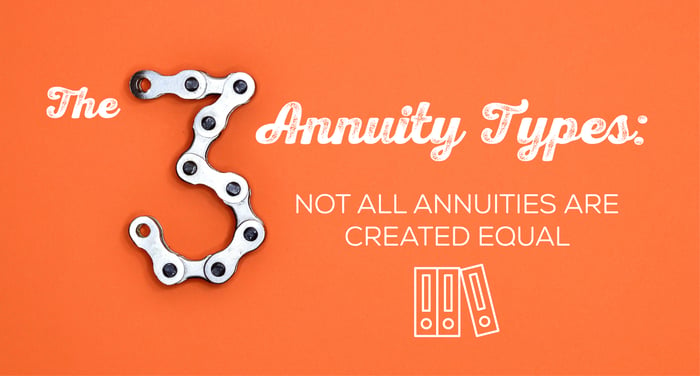There’s a bad taste in the mouth of many consumers when it comes to the word “annuity.” The second they hear it, they cross their arms, furrow their brows, and proceed to daydream about their plans for the evening.
It’s almost as if every word in your presentation that comes after “annuity” is cursed.
For many individuals, it’s negative reviews they’ve heard from family and friends. “My cousin got one of those annuities and ended up losing money because of all these hidden fees!”
And for others, it’s even negative press coming from their financials planners and advisors!
But what we find is that all the bad press is coming from one type of annuity – variable annuities.
And that’s just one type of annuity. In reality, there are 3 types of annuities, and all of them perform and act very differently.
It’s as if one sorry person had to ruin it for everyone.
Now, that’s not to say that variable annuities are inherently bad – they’re just different. Very different. They have their place, though not necessarily in the senior market.
And understanding the difference between the 3 main types of annuities will go a long way for you.
Not only will you be able to shed some light on this issue for your clients, but you’ll start to understand what potential options are out there.
New to annuity sales?
Annuity sales are a huge opportunity for independent agents in the senior market. If you want to learn how to sell annuities to seniors, you've come to the right place!
Check out our complete guide here: The Ultimate Guide to Selling Annuities In the Senior Market
3 Main Types of Annuities
We’ve got 3 main types of annuities:
- SPIAs (Single Premium Income Annuity)
- Fixed
- Variable
A quick note: the “Fixed” annuity category has 3 sub-categories: Traditional Fixed, MYGA, and FIA.
While every product has its quirks, add-ons, and riders, there’s something to be said about understanding the gist of how the product works.
So, we’ll go over the basics – the super basics – so that you can understand the base product.
If you see something that sounds like it could help some of your clients… who you gonna call?
NEW HORIZONS!
Sorry. We couldn’t help it.
Annuity Type #1: SPIAs
If you break down the product name (flashback to second grade), you can easily figure out what a SPIA is.
A Single Premium Income Annuity (SPIA) works like this:
- You pay the insurance company a lump sum (Single Premium)
- The company pays you a certain amount of money, periodically, for the rest of your life (Income Annuity)
The beauty of SPIAs compared to other options like stocks or bonds is that they allow for a higher withdrawal rate, they’re completely safe (no risk), and they’re predictable.
If you know you need $2,000 per month during retirement, you can plan for exactly that.
The downside? Once you start the contract, that money is no longer in your control – the insurance company has control.
Annuity Type #2: Fixed Annuities
There are actually 3 types of fixed annuities, and we’ll give you a brief primer on all three. We’ll give you a quick definition, an example of how it works, and our thoughts on it.
Traditional Fixed
Definition: You have a guaranteed rate of return each year. You will not get more or less than that rate.
Example: I have $50,000, and for this example, we'll assume that the interest is compounding. The contract says the rate of return for the first year is 2%, so you end the year with $51,000. The next year, the rate of return is 1.95%, so you end the year with $51,995. This continues on.
Sidenote: Traditional Fixed annuities aren’t that popular right now. The rates aren’t as good as the next type of annuity. Also, many companies have stopped offering it.
MYGA (Multi-Year Guaranteed Annuity)
Definition: You have a guaranteed rate of return for an entire surrender charge period. Common MYGA contracts are 3, 5, or 10 years long.
Example: I have $50,000. The 5-year contract says the rate of return is 3.65%. At the end of the 1st year, your account would be worth $51,825. Assuming the contract is compounding, you’d end year 2 at $53,716, year 3 at $55,677, and so on until the 5 years is up.
Sidenote: This is the most popular type of annuity we sell. It’s very simple for seniors to understand, and the rate is so much better than you can get with a CD or the Money Markets, which is a huge draw.
FIA (Fixed Index Annuity)
Definition: You have the choice of adding “interest crediting strategies.” With FIAs, you might get 0% returns, but you have the potential of earning higher returns based on how the stock market performs. You never experience the losses, but you can safely experience the gains. Common FIA contracts are 7 or 10 years long.
Example: I have $50,000. I choose an annual point-to-point interest crediting strategy based on the S&P 500. My cap is 6%. Over the first year of my contract, the S&P 500 went up 8%. I’m capped at 6%, so my account value goes up to $53,000 at the end of the first year. Over the course of the next year, the S&P went down 2%. I don’t lose anything, but I don’t gain anything either. My account value stays at $53,000. This goes on until the contract is over.
Sidenote: FIAs are gaining traction, particularly because of the potential to earn more than the other types of annuities. If you have clients who want to participate in the stock market (without going negative), this is a real contender. Also, there is an income rider you can add, which is actually really popular. Our friends at Brokers International say that about 60% of the FIAs sold have an income rider attached.
For New Horizons, MYGAs are our most popular form of annuities across the board. Seniors like the return (generally a little better than 3%), it has zero risk, and most people feel comfortable with putting their money in a contract for 5 years.
Once that 5-year contract is up, you can take that money out with no surrender charge, or you can renew the contract for another 5 years.
We’re pretty excited about FIAs, though, because it allows seniors to experience the gains of the stock market without taking on any risk. The income rider option is also very attractive, especially if your clients are concerned with outliving their money.
FIAs are quickly gaining popularity, and we can see why!
To read more on FIAs, and to see a short video on how 3 indexing strategies work, you can visit The Safest Way to Be Risky: Fixed Annuities With an Indexing Option.
That article also has a ton of common FAQs that will familiarize you with the product.
Annuity Type #3: Variable Annuities
Because we’re in the senior market, we don’t even offer variable annuity products.
They are much more complex than the other 2 we’ve gone over, you have to have a securities license to sell them (or even talk about them to clients), and they’re not a zero-risk way to make a return on your money.
In short, variable annuities are registered as a security. The premium is invested into “sub-accounts,” which are similar to mutual funds.
The sub-accounts are portfolios of stocks and bonds. There is a higher potential for gains, but seniors will not like that there’s also the chance of experiencing losses.
You’re participating more in the risk of the underlying index. Your money is now at risk. Unlike the other annuities we’ve covered, zero is no longer the worst you can do – you can actually lose money.
Variable annuities also can have embedded fees that are troublesome. These aren’t “bad” products, and they certainly have their place with a certain age range and type of investor, but it’s not a safe way to fund a retirement.
And that’s why so many financial planners advise people against annuities, especially when the conservation is about planning for retirement. The problem? Variable annuities weren’t built for retirement saving.
But SPIAs and Fixed annuities are – at their core, they’re retirement savings vehicles.
What next?
As you’ve probably gathered from this article, there are 3 annuity types that suit our senior market the best:
- SPIAs
- MYGAs
- FIAs
All the acronyms it seems. Traditional Fixed annuities aren’t competitive right now, and variable annuities aren’t the right fit for the senior market.
If you have any interest in learning more about these, please let us know. Also, add any questions you may have to the comment section below!
We'll follow up in the weeks to come with more detailed product information, but if you ever need a refresher on the base of how the different annuity products work, we hope this article will be your calling card.







